Submitted:
28 July 2023
Posted:
31 July 2023
You are already at the latest version
Abstract
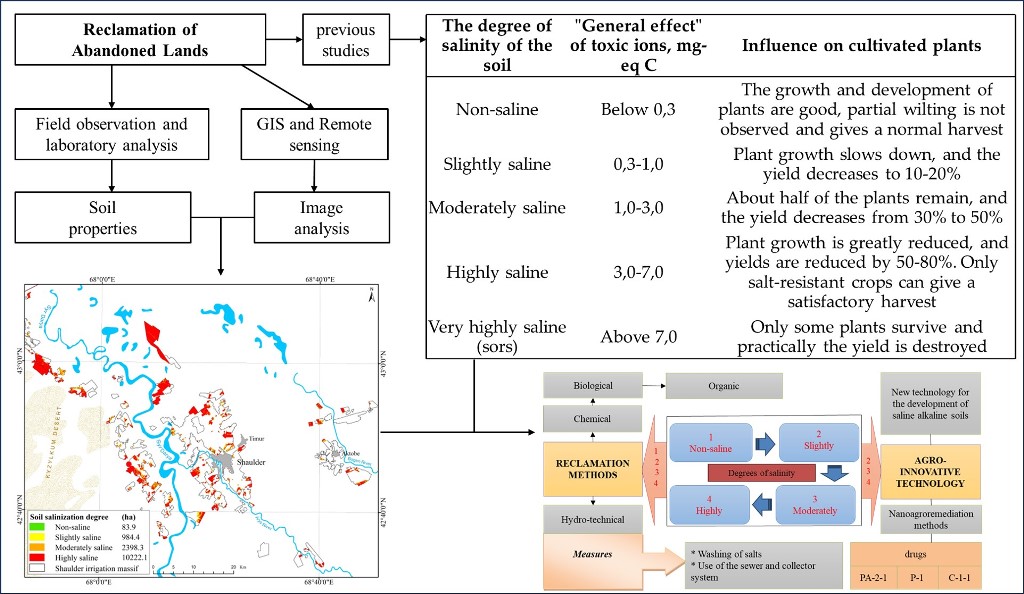
Keywords:
1. Introduction
2. Materials and Methods
2.1. Description of the Study Area
2.2. The Data and Research Methods
3. Results
3.1. Definition of the Territory of Abandoned Lands
3.2. Ecological and Reclamation Condition of Abandoned Lands
4. Discussion
5. Conclusions
Author Contributions
Funding
Institutional Review Board Statement
Informed Consent Statement
Data Availability Statement
Acknowledgments
Conflicts of Interest
References
- United Nations, World Population Prospects 2022: Summary of Results. 2022. Available online: https://www.un.org/development/desa/pd/content/World-Population-Prospects-2022 (accessed on 2022).
- Alcantara, C.; Kuemmerle, T.; Baumann, M.; Bragina, E.V.; Griffiths, P.; Hostert, P. . & Radeloff, V.C. Mapping the extent of abandoned farmland in Central and Eastern Europe using MODIS time series satellite data. Environmental Research Letters 2013, 3, 035035. [Google Scholar]
- Meyer, W.B.; Turner, B.L. Human population growth and global land-use/cover change. Annual review of ecology and systematics 1992, 1, 39–61. [Google Scholar] [CrossRef]
- UN official website, Sustainable Development Goals. Available online: https://www.un.org/sustainabledevelopment/sustainable-development-goals/.
- Yang, Y.; Hobbie, S.E.; Hernandez, R.R.; Fargione, J.; Grodsky, S.M.; Tilman, D.; et al. Restoring abandoned farmland to mitigate climate change on a full Earth. One Earth 2020, 2, 176–186. [Google Scholar] [CrossRef]
- Benjamin, K.; Domon, G.; Bouchard, A. Vegetation Composition and Succession of Abandoned Farmland: Effects of Ecological, Historical and Spatial Factors. Landscape Ecol. 2005, 20, 627–647. [Google Scholar] [CrossRef]
- Ruskule, A.; Nikodemus, O.; Kasparinskis, R.; Bell, S.; Urtane, I. The perception of abandoned farmland by local people and experts: Landscape value and perspectives on future land use. Landscape and Urban Planning 2013, 115, 49–61. [Google Scholar] [CrossRef]
- Committee of the Ministry of Agriculture of the Republic of Kazakhstan, Summary analytical report on the state and land use of the Republic of Kazakhstan for 2021. 2022. Available online: https://www.gov.kz/memleket/entities/land/documents/details/291911?lang=ru (accessed on 05 April 2022).
- Yessimbekov, M.B. Scientific and experimental foundations of the development of saline soils for rice culture in Kazakhstan. Doctor of Agricultural Sciences, Republican State Enterprise Scientific and Production Center for Agriculture and Plant Farming, Almaty. 2010. (in Russian).
- Otarov, A.; Ibraeva, M.A. Recommendations for the development of secondary saline "fallow" lands of irrigated zones in conditions of unfavorable reclamation situation. Kazakh Research Institute of Soil Science and Agrochemistry named after U.U.Uspanov. Almaty, Kazakhstan, 2011; p. 27.
- Laiskhanov, S. Agrolandscapes of Otrar district. Monograph.; (in Kazakh). Daryn: Almaty, Kazakhstan, 2022; p. 233. [Google Scholar]
- Official website of the president of the Republic of Kazakhstan. Nation address of the head of state Kassym-Jomart Tokayev to the people of Kazakhstan. Available online: https://www.akorda.kz/kz/addresses/addresses_of_president/memleket-basshysy-kasym-zhomart-tokaevtyn-kazakstan-halkyna-zholdauy (accessed on 02 September 2019).
- Smanov, Z.M.; Suleimenova, A.I.; Poshanov, M.N.; Duisekov, S.N.; Vyrakhmanova, A.S. The modern reclamation state of irrigated soils and the methodology of their study on the example of the SEC "Asia Agro Group". Soil science and agrochemistry. (in Kazakh). 2023, 1, 15–35. [Google Scholar]
- Diacono, M.; Montemurro, F. Effectiveness of organic wastes as fertilizers and amendments in salt-affected soils. Agriculture 2015, 5, 221–230. [Google Scholar] [CrossRef]
- Favorin, Nikolai Nikolaevich. Irrigation canals and groundwater; Publishing House of the Academy of Sciences of the USSR: Moscow; USSR, 1954; p. 93. (in Russian).
- Ayers, R.S.; Westcot, D.W. Water quality for agriculture; Food and Agriculture Organization of the United Nations: Rome, Italy, 1985; Volume 29, p. 174. [Google Scholar]
- Abrol, I.P.; Yadav, J.S.P.; Massoud, F.I. Salt-affected soils and their management (Vol. 39). Food & Agriculture Org. Rome, Italy, 1988, Vol. 39.
- Seitkaziev, A.S.; Dauletbayev, B.U. Problems of hydrochemical regime on ecosystems of gray-earth soils of the south of Kazakhstan. Dulaty University Bulletin 2007, 7, 24–27. (in Russian). [Google Scholar]
- Kiryushin, V.I. Theory of adaptative landscape agriculture and design of agricultural landscapes; Kolos: Moscow, Russia, 2011; p. 443. (in Russian) [Google Scholar]
- Yang, T.; Šimůnek, J.; Mo, M.; Mccullough-Sanden, B.; Shahrokhnia, H.; Cherchian, S.; Wu, L. Assessing salinity leaching efficiency in three soils by the HYDRUS-1D and -2D simulations. Soil and Tillage Research 2019, 194, 104342. [Google Scholar] [CrossRef]
- Abolin, R.I. To the question of the classification and terminology of soils in the desert zone of Turkestan. Irrigation, Sel. Economy and animal husbandry 1922, 3, 27. (in Russian). [Google Scholar]
- Myshko, M.N. Yield and quality of corn depending on fertilizers on the leached chernozem of Kuban. Dissertation for the degree of candidate of agricultural sciences, Kuban State University, Krasnodar, Russia,.01.06.2004. (in Russian).
- Ahmad, N.; Qureshi, R.H.; Qadir, M. Amelioration of calcareous saline-sodic soil by gypsum and forage plants. Land Degrad. Rehabil. 1990, 2, 277–284. [Google Scholar] [CrossRef]
- Birru, G.A.; Clay, D.E.; DeSutter, T.M.; Reese, C.L.; Kennedy, A.C.; Clay, S.A.; Bruggeman, S.A.; Owen, R.K.; Malo, D.D. Chemical Amendments of Dryland Saline–Sodic Soils Did Not Enhance Productivity and Soil Health in Fields without Effective Drainage. Agronomy Journal 2019, 111, 496–508. [Google Scholar] [CrossRef]
- Gonçalo Filho, F.; da Silva Dias, N.; Suddarth, S.R.P.; Ferreira, J.F.; Anderson, R.G.; dos Santos Fernandes, C.; de Lira, R.B.; Neto, M.F.; Cosme, C.R. Reclaiming Tropical Saline-Sodic Soils with Gypsum and Cow Manure. Water 2020, 1, 57. [Google Scholar] [CrossRef]
- Tagaev, A.; Umbetaev, I. Intensity of biomelioration in gray-earth soils. Science, production, business: the current state and ways of innovative development of the agricultural sector on the example of the Agricultural Holding "Bayserke-Agro", Almaty, Kazakhstan, 4-5 April 2019. Proceedings of the international scientific and practical conference dedicated to the 70th anniversary of the Honored Worker of the Republic of Kazakhstan Dosmukhambetov Temirkhan Mynaidarovich. 5 April.
- Rabbimov, A.; Bekchanov, B.; Mukimov, T. Chemical composition and palatability of some species of halophytes. Arid Ecosyst. 2011, 1, 104–109. [Google Scholar] [CrossRef]
- Kahlown, M.A.; Azam, M. Effect of saline drainage effluent on soil health and crop yield. Agricultural Water Management. 2003, 62, 127–138. [Google Scholar] [CrossRef]
- Wang, L.; Ok, Y.S.; Tsang, D.C.; Alessi, D.S.; Rinklebe, J.; Wang, H.; Hou, D. New trends in biochar pyrolysis and modification strategies: Feedstock, pyrolysis conditions, sustainability concerns and implications for soil amendment. Soil Use and Management 2020, 36, 358–386. [Google Scholar] [CrossRef]
- Wang, S.; Gao, P.; Zhang, Q.; Shi, Y.; Guo, X.; Lv, Q.; Wu, W.; Zhang, X.; Li, M.; Meng, Q. Application of biochar and organic fertilizer to saline-alkali soil in the Yellow River Delta: Effects on soil water, salinity, nutrients, and maize yield. Soil Use and Management 2022, 38, 1679–1692. [Google Scholar] [CrossRef]
- Tejada, M.; Garcia, C.; Gonzalez, J.L.; Hernandez, M.T. Use of organic amendment as a strategy for saline soil remediation: Influence on the physical, chemical and biological properties. Soil Biol. Biochem. 2006, 38, 1413–1421. [Google Scholar] [CrossRef]
- Mamonov, A.G.; Mamutov, Z.U.; Gladkiy, V.E.; Mamonov, N.A.; Argymbayev, S.M. Nanomeliorative techniques of new agrotechnologies for increasing soil fertility and crop productivity: methodological recommendations. Kazakh Research Institute of Soil Science and Agrochemistry named after U.U.Uspanov. Almaty, Kazakhstan, 2008; p. 35.
- Saparov, A.S.; Oshakbaeva, Z.O.; Atasheva, G.A. Characteristics of preparations-2-1 and C-1-1 and their mechanism of influence. Bulletin of the National academy of sciences of Republic of Kazakhstan 2015, 2, 90–92. (in Kazakh). [Google Scholar]
- Poshanov, M.N.; Laiskhanov, S.U.; Smanov, Z.M.; Kenenbayev, S.B.; Aliaskarov, D.T.; Abikbayev, Y.R.; Vyrakhmanova, A.S.; Askanbek, A. The Effects of the Degree of Soil Salinity and the Biopreparation on Productivity of Maize in the Shaulder Irrigated Massif. OnLine Journal of Biological Sciences 2022, 22, 58–67. [Google Scholar] [CrossRef]
- Ibraeva, M.A.; Saparov, A.S.; Suleimenova, A.I.; Serikbai, G.; Shaukharova, D.; Dzhumanova, M. Mineral nutrition and productivity of corn for grain in saline meadow-gray soils of the Shaulder irrigation array. Soil Science and Agrichemistry 2020, 1, 16–28. (in Russian). [Google Scholar]
- Shaygan, M.; Baumgartl, T. Reclamation of Salt-Affected Land: A Review. Soil Syst. 2022, 6, 61. [Google Scholar] [CrossRef]
- Laiskhanov, S.U.; Smanov, Z.M.; Kaimuldinova, K.D.; Myrzaly, N.B.; Ussenov, N.E.; Poshanov, M.N.; Azimkhanov, B. A Study of the Effects of Soil Salinity on the Growth and Development of Maize (Zea Mays L.) by using Sentinel-2 Imagery. OnLine Journal of Biological Sciences 2022, 22, 323–332. [Google Scholar] [CrossRef]
- Laiskhanov, S.U.; Otarov, A.; Savin, I.Y.; Tanirbergenov, S.I.; Mamutov, Z.U.; Duisekov, S.N.; Zhogolev, A. Dynamics of Soil Salinity in Irrigation Areasin South Kazakhstan. Polish Journal of Environmental Studies 2016, 6, 2469–2475. [Google Scholar] [CrossRef] [PubMed]
- Agency for Strategic planning and reforms of the Republic of Kazakhstan Bureau of National statistics. Agriculture, Forestry and Fisheries 2017-2021. 2022. Available online: https://old.stat.gov.kz/region/20243032/statistical_information/publication (accessed on January and February 2022).
- United Nations Environment Programme, World Atlas of Desertification. Available online: https://wedocs.unep.org/20.500.11822/42137 (accessed on 15 Jul 2023).
- Laiskhanov, S.U.; Poshanov, M.N.; Smanov, Z.M.; Tleubergenova, K.A.; Ashimov, T.A. A Study of the Processes of Desertification at the Modern Delta of the Ili River with the Application of Remote Sensing Data. Journal of Ecological Engineering 2021, 3, 169–178. [Google Scholar] [CrossRef]
- Smanov, Z.M.; Laiskhanov, S.U.; Poshanov, M.N.; Abikbayev, Y.R.; Duisekov, S.N.; Tulegenov, Y.A. Mapping of Cornfield Soil Salinity in Arid and Semi-Arid Regions. Journal of Ecological Engineering 2023, 1, 146–158. [Google Scholar] [CrossRef]
- Mamutov, Z.U.; Mamontov, V.G.; Esimbekov, M.B. Interpretation of the data of the aqueous extract from saline soils; Polygraphy–Service K: Almaty, Kazakhstan, 2011: p. 75.
- Hatna, E.; Bakker, M.M. Abandonment and expansion of arable land in Europe. Ecosystems 2011, 14, 720–731. [Google Scholar] [CrossRef]
- Kovda, V.A. Origin and regime of saline soils; Academy of Sciences of the USSR: Moscow; Leningrad, USSR, 1946; p. 574. (in Russian).
- Chen, M.M.; Zhang, S.R.; Liu, L.; Wu, L.P.; Ding, X.D. Combined organic amendments and mineral fertilizer application increase rice yield by improving soil structure, P availability and root growth in saline-alkaline soil. Soil and Tillage Research 2021, 212, 105060. [Google Scholar] [CrossRef]
- Zhang, Z.; Liu, H.; Liu, X.; Chen, Y.; Lu, Y.; Shen, M. . & Li, J. Organic fertilizer enhances rice growth in severe saline–alkali soil by increasing soil bacterial diversity. Soil Use and Management 2022, 38, 964–977. [Google Scholar]
- Bureau of National Statistics of the Agency for Strategic Planning and Reforms of the Republic of Kazakhstan, Brief Statistical Yearbook 2022. 2023. Available online: https://stat.gov.kz/ru/region/turkestan/collections/?year=2022&period=year&name=52710 (accessed on 30 May 2023).
- Unified ecological Internet resource of the Ministry of Ecology and Natural Resources of the Republic of Kazakhstan, Information Bulletins for 2020. Available online: https://ecogosfond.kz/orhusskaja-konvencija/dostup-k-jekologicheskoj-informacii/jekologijaly-zha-daj/orsha-an-otrany-zhaj-k-ji-turaly-a-paratty-bjulletender/ru-informacionnye-bjulleteni-za-2020-g/ (accessed on 2020).
- Koshkarov, S.I.; Baisalova, Z.A.; Kazbekov, B.M. Water quality of the Syrdarya River and ecological reclamation status of irrigated land. Bulletin 2008, 8, 38–39. (in Kazakh). [Google Scholar]
- Mostafazadeh-Fard, B.; Heidarpour, M.; Aghakhani, A.; Feizi, M. Effects of Irrigation Water Salinity and Leaching on Soil Chemical Properties in an Arid Region. International Journal of Agriculture and Biology 2007, 1, 20–29. [Google Scholar]

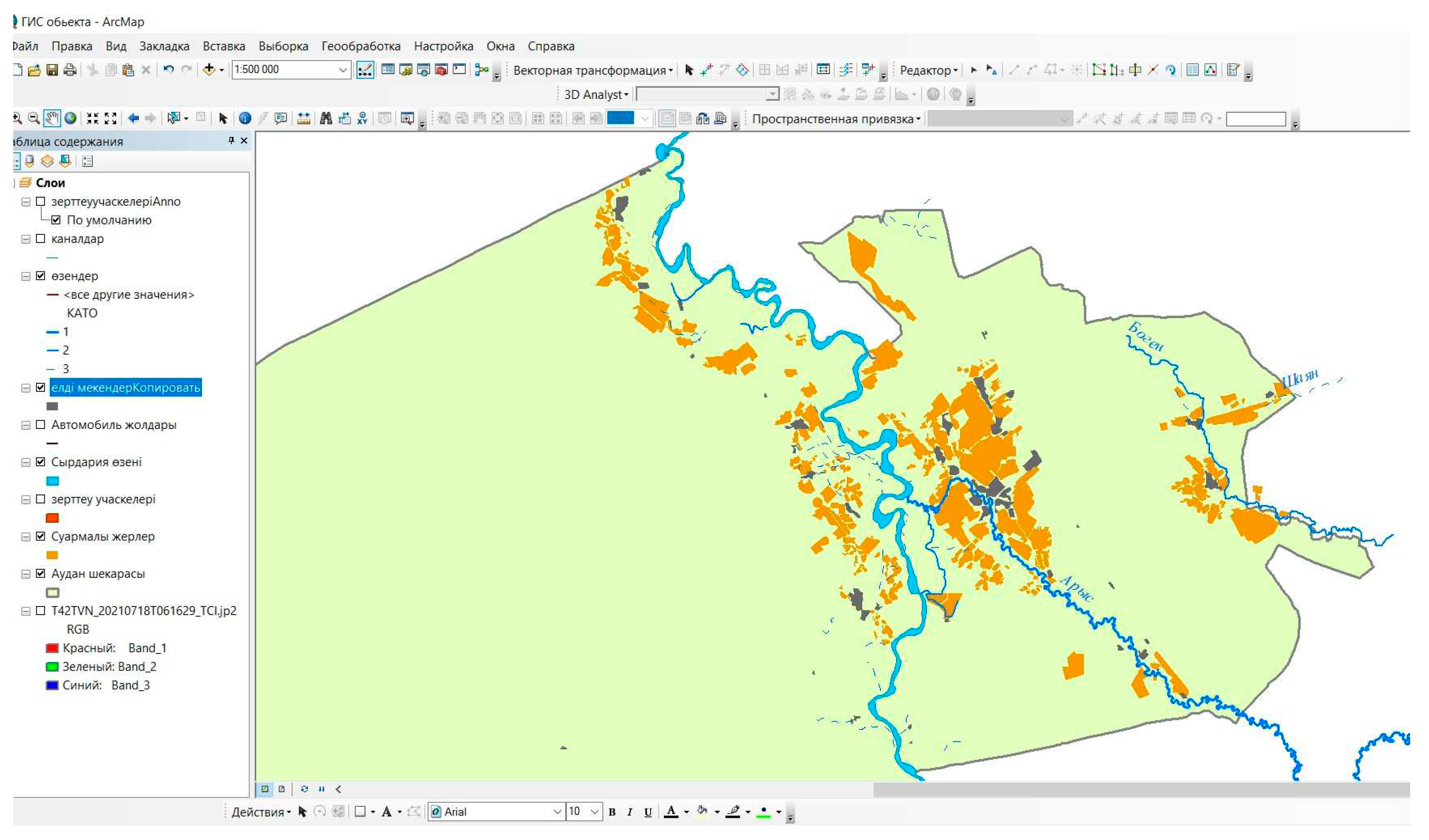
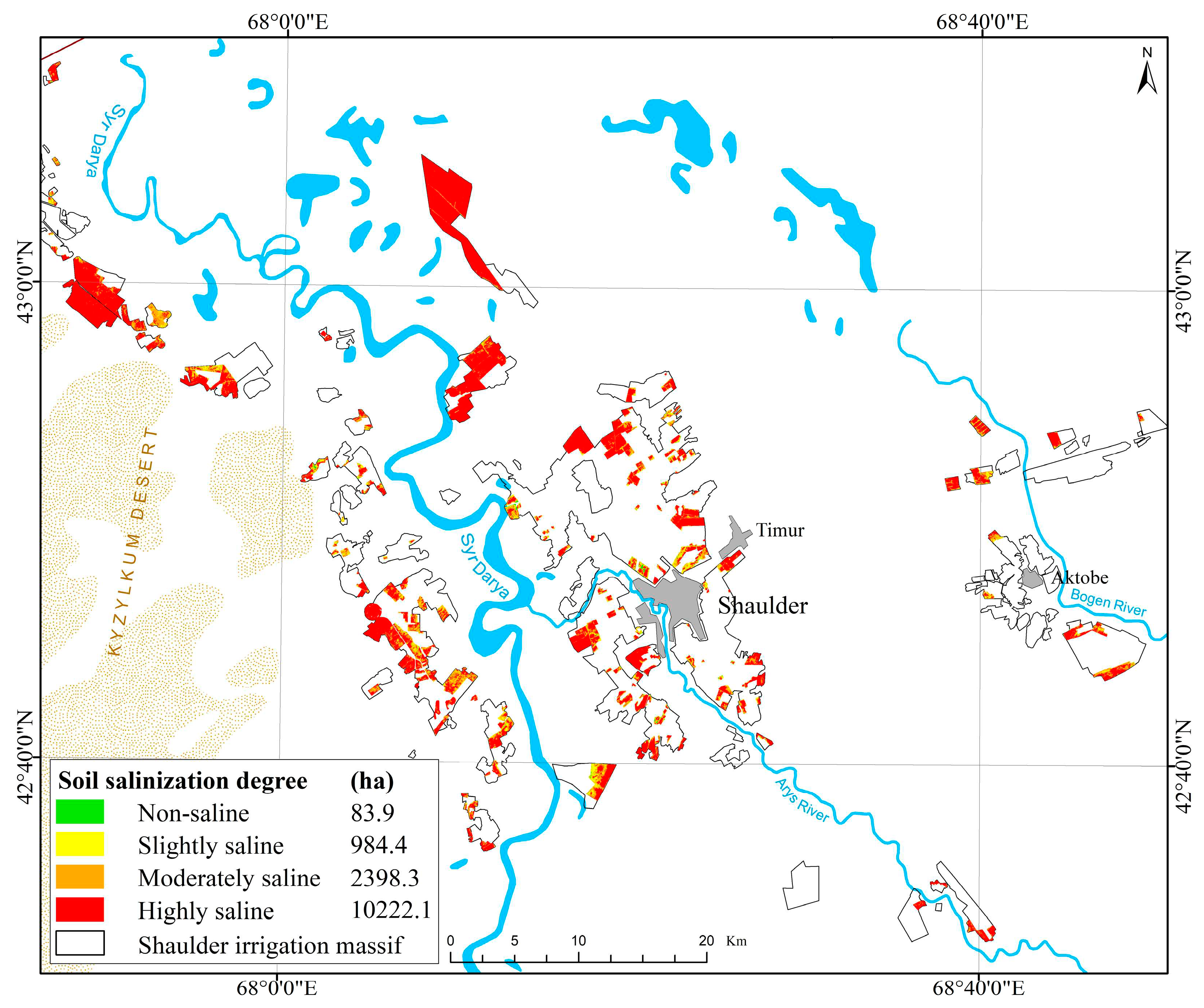
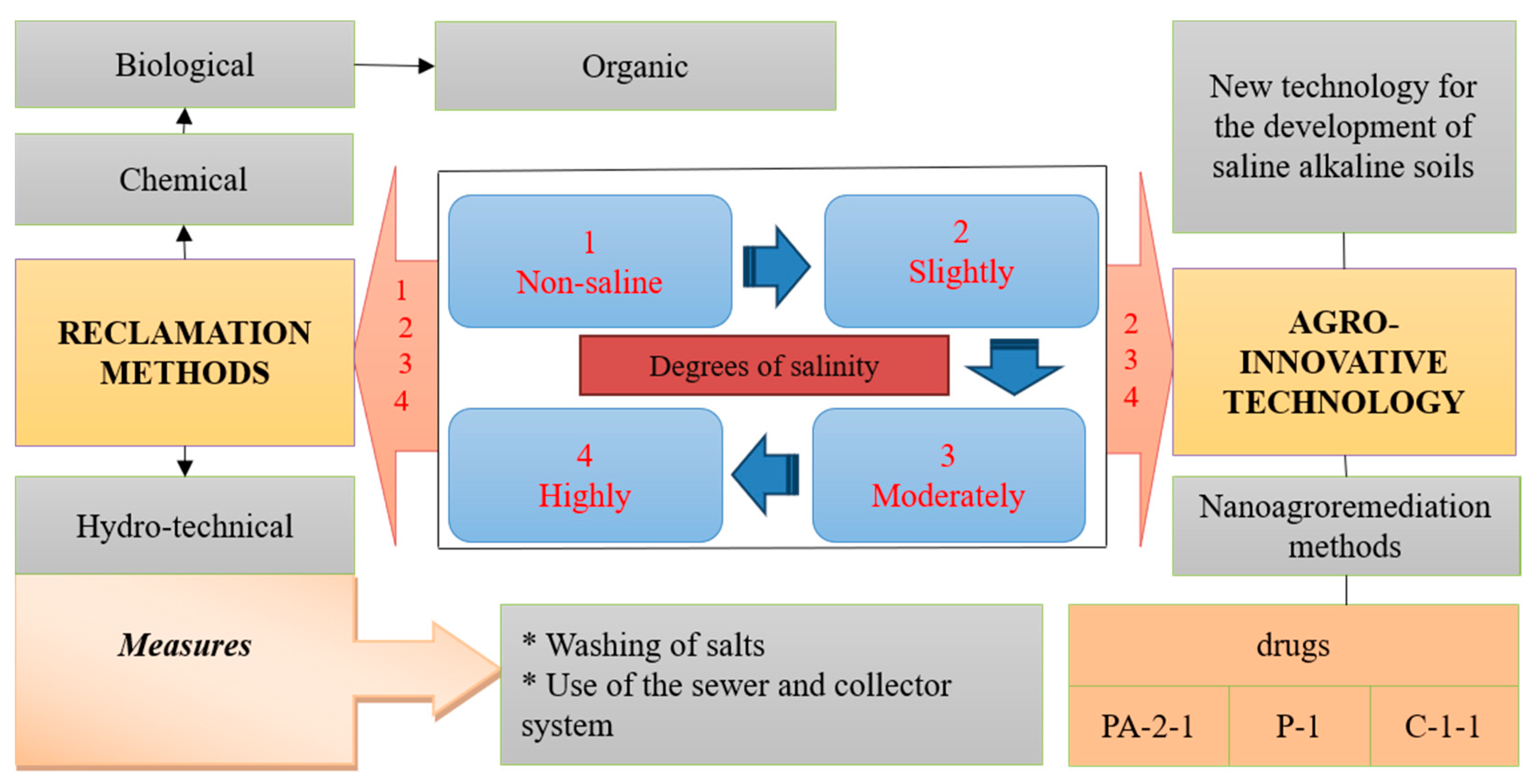
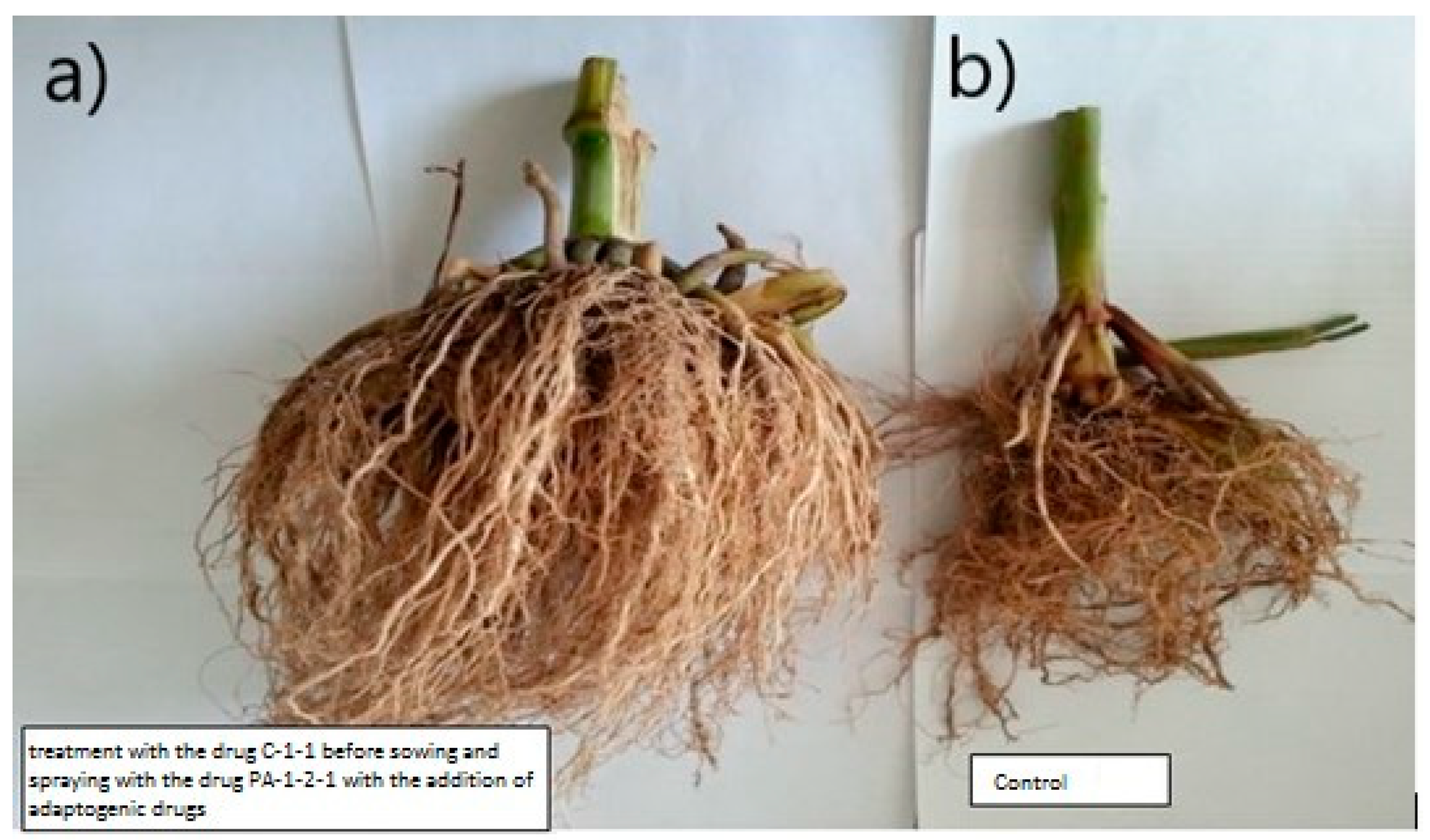
| The degree of salinity of the soil | "General effect" of toxic ions, mg-eq C | Influence on cultivated plants |
| Non-saline | Below 0,3 | The growth and development of plants are good, partial wilting is not observed and gives a normal harvest |
| Slightly saline | 0,3-1,0 | Plant growth slows down, and the yield decreases to 10-20% |
| Moderately saline | 1,0-3,0 | About half of the plants remain, and the yield decreases from 30% to 50% |
| Highly saline | 3,0-7,0 | Plant growth is greatly reduced, and yields are reduced by 50-80%. Only salt-resistant crops can give a satisfactory harvest |
| Very highly saline (sors) | Above 7,0 | Only some plants survive and practically the yield is destroyed |
Disclaimer/Publisher’s Note: The statements, opinions and data contained in all publications are solely those of the individual author(s) and contributor(s) and not of MDPI and/or the editor(s). MDPI and/or the editor(s) disclaim responsibility for any injury to people or property resulting from any ideas, methods, instructions or products referred to in the content. |
© 2023 by the authors. Licensee MDPI, Basel, Switzerland. This article is an open access article distributed under the terms and conditions of the Creative Commons Attribution (CC BY) license (http://creativecommons.org/licenses/by/4.0/).





